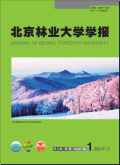北京林业大学学报2024,Vol.46Issue(4):40-51,12.DOI:10.12171/j.1000-1522.20220462
北京百花山落叶阔叶林群落内木本植物的叶片功能性状变异特征
Variation characteristics in leaf functional traits of woody plants in deciduous broadleaved forest community in Baihua Mountain of Beijing
摘要
Abstract
[Objective]This study aimed to provide a theoretical basis for elucidating the coexistence mechanism of typical temperate deciduous broadleaved woody plants by revealing the variation characteristics,sources of variation,and interrelationships among functional traits of leaf morphology and biochemical traits of different life forms of plants.[Method]We investigated 8 leaf functional traits for 23 woody plants,including 12 shrubs and 11 trees in a deciduous broadleaved forest in Baihuashan Nature Reserve in Beijing,analyzed the variation characteristics of the leaf functional traits and relationships between these traits,and further examined the driving forces of the variations and plant ecological adaptation strategies.[Result](1)There was no significant difference in leaf carbon,nitrogen and phosphorus content,leaf relative water content and leaf tissue density between tree and shrub species.However,the specific leaf area of tree species was significantly lower than that of shrub species,and leaf thickness and leaf dry matter content were significantly higher than that of shrub species.(2)For most leaf traits,species was the best factor to explain the variation in leaf functional traits.The variations in leaf thickness and specific leaf area mainly came from species itself and life form,and the variation in leaf dry matter content was explained by species,individuals and life form.(3)In addition,the results of trait information axis showed that most shrub species were located at the end of the fast investment income of the leaf economic spectrum,while tree species were located at the end of the slower investment income.These differences indicated that there were diverse trade-off strategies for plant traits to adapt to environmental heterogeneity,and according to our findings,the specific leaf area was the key variable to divide the ecological strategies of two life-form plants.[Conclusion]Different life-form woody plants can acclimate to the resource variation along a vertical canopy gradient by optimizing a combination of leaf structural traits.The slight environmental differences between habitats will accelerate niche differentiation of coexisting plants in the community.关键词
叶片功能性状/种间变异/乔木/灌木/落叶阔叶林/物种共存Key words
leaf functional trait/interspecific variation/tree/shrub/deciduous broadleaved forest/species coexistence分类
林学引用本文复制引用
高永龙,孙艳丽,徐铭泽,刘杉..北京百花山落叶阔叶林群落内木本植物的叶片功能性状变异特征[J].北京林业大学学报,2024,46(4):40-51,12.基金项目
国家重点研发计划项目(2020YFA0608103),北京园林绿化生态系统监测网络项目(GJH-2023-027). (2020YFA0608103)

